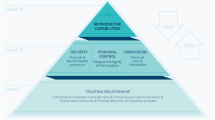Abstract
We describe the validity and reliability of midwife-administered postpartum questionnaires in home and clinic settings. Women identified prospectively before or following hospital delivery (n = 476), September 2004–January 2005, were re-contacted at 6 months postpartum for home interview and medical examination. Reliability was measured by comparing women’s responses to the same questions at home and in clinic interviews. Validity was measured by comparing questionnaire responses with results of medical examination. Reliability of responses to questions comparing home and clinic interview was very good (κ > 0.6) for resumption of menstruation and occurrence of hemorrhoids, moderate (0.4 < κ ≤ 0.6) for weight loss and incontinence, and poor (κ ≤ 0.4) for burning sensation or pain on urination and exhaustion or fatigue. The home and clinic interviews had poor validity for detecting common postpartum morbidities: anaemia (sensitivity 33.7%, specificity 65.7%), urinary incontinence (5.1, 98.1%), urinary tract infection (2.1, 94.5%), prolapse (18.2, 91.2%); but good validity for hemorrhoids (71.4, 86.9%). In this setting, questionnaire-based interviews were neither reliable nor valid tools for measuring morbidity at 6 months postpartum. A medical examination is required to identify and measure the levels of morbidity up to 6 months postpartum.
Similar content being viewed by others
References
Waterstone, M., Wolfe, C., Hooper, R., & Bewley, S. (2003). Postnatal morbidity after childbirth and severe obstetric morbidity. British Journal of Obstetrics and Gynaecology, 110(2), 128–133.
Filippi, V., Ganaba, R., Baggaley, R. F., Marshall, T., Storeng, K. T., Sombié, I., et al. (2007). Health of women after severe obstetric complications in Burkina Faso: A longitudinal study. The Lancet, 370(9595), 1329–1337.
Hurt, L. S., Alam, N., Dieltiens, G., Aktar, N., & Ronsmans, C. (2008). Duration and magnitude of mortality after pregnancy in rural Bangladesh. International Journal of Epidemiology, 37, 397–404, 4.
Zurayk, H., Khattab, H., Younis, N., Kamal, O., & El-Helw, M. (1995). Comparing women’s reports with medical diagnoses of reproductive morbidity conditions in rural Egypt. Studies in Family Planning, 26(1), 14–21.
Filippi, V., Marshall, T., Bulut, A., Graham, W., & Yolsal, N. (1997). Asking questions about women’s reproductive health: Validity and reliability of survey findings from Istanbul. Tropicical Medicine and International Health, 2(1), 47–56.
Filippi, V., Goufodji, S., Sismanidis, C., Kanhonou, L., Fottrell, E., Ronsmans, C., et al. (2010). Effects of severe obstetric complications on women’s health and infant mortality in Benin. Tropical Medicine and International Health, 15(6), 733–742.
Fottrell, E., Kanhonou, L., Goufodji, S., Behague, D. P., Marshall, T., Patel, V., et al. (2010). Risk of psychological distress following severe obstetric complications in Benin: The role of economics, physical health and spousal abuse. The British Journal of Psychiatry ,196(1), 18.
Ronsmans, C. (1996). Studies validating women’s reports of reproductive ill health: How useful are they? In Innovative approaches to the assessment of reproductive health, organised by the committee on reproductive health of the International Union for the Scientific Study of Population (p. 9). Manila, The Philippines, 24–27 Sept 1996.
Koenig, M., Jejeebhoy, S., Singh, S., & Sridhar, S. (1998). Investigating women's gynaecological morbidity in India: Not just another KAP survey. Reproductive Health Matters, 6(11), 84–97.
Sadana, R. (2000). Measuring reproductive health: Review of community-based approaches to assessing morbidity. Bulletin of the World Health Organization, 78(5), 640–654.
Walraven, G., Scherf, C., West, B., Ekpo, G., Paine, K., Coleman, R., et al. (2001). The burden of reproductive-organ disease in rural women in the Gambia, West Africa. The Lancet, 357, 1161–7, 4.
Acknowledgments
This work was funded by the Human Reproduction Programme at the World Health Organization, with contributions from staff in the Maternal Health Group at the London School of Hygiene and Tropical Medicine who are funded by the Department for International Development. The funders have no responsibility for the information provided or views expressed in this paper.
Author information
Authors and Affiliations
Corresponding author
Rights and permissions
About this article
Cite this article
Montgomery, A., Goufodji, S., Kanhonou, L. et al. Validity and Reliability of Postpartum Morbidity Questionnaires in Benin. Matern Child Health J 16, 1728–1731 (2012). https://doi.org/10.1007/s10995-011-0859-9
Published:
Issue Date:
DOI: https://doi.org/10.1007/s10995-011-0859-9




